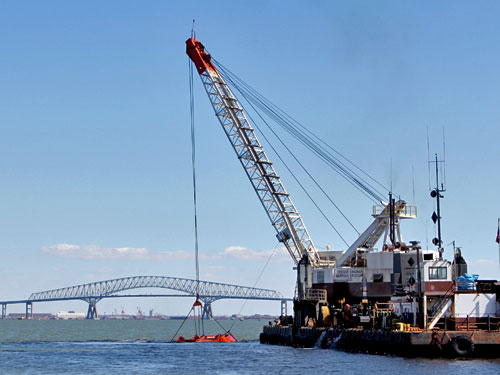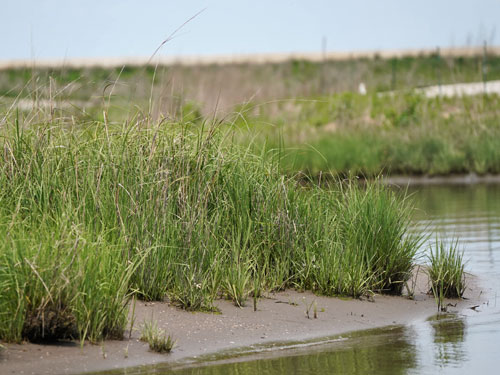
A variety of federal, state, and private projects are underway to support the Port of Baltimore. Work includes port infrastructure upgrades, channel and harbor dredging, tunnel construction, civil engineering, and other projects.
Port stakeholders include the U.S. Environmental Protection Agency (EPA), U.S. Coast Guard, U.S. Army Corps of Engineers, Baltimore District, Maryland Port Administration, Ports America Chesapeake, longshoremen, residents, and others.
This article summarizes major improvement projects around the Port of Baltimore during the period from 2018-2022.
New Container Shipping Lines
In 2022, Israel-based ZIM Shipping Line is expected to begin calls at the Helen Delich Bentley Port of Baltimore. The new service, named Zim e-Commerce Baltimore express (ZXB), will provide service from China and Southeast Asia to the U.S. East Coast.
ZIM operates a fleet of close to 100 vessels, and is a significant participant in international container shipping with a sizeable market share. ZIM’s global footprint includes trade lanes in the Transpacific, Cross Atlantic, Cross Suez, Intra-Asia, and Latin America.
ZXB is operated exclusively by ZIM and offers its customers the fastest transit time from Asia to Baltimore, guaranteed space, and equipment without rolling, late cutoff from Asia ports, a dedicated out-of-gate lane, and expedited rail/air/road connections to inland destinations.
The addition of ZIM follows two recent container services that recently began at the Port of Baltimore: a new Southeast Asia, Vietnam and China service on Maersk and a new Indian Subcontinent and Mediterranean service through Mediterranean Shipping Co.
Neo-Panamax Container Cranes
In September 2021, four additional supersized, Neo-Panamax container cranes were added as part of a $166 million investment made by Ports America Chesapeake at the Seagirt Marine Terminal. The new cranes will serve the Port’s second 50-foot-deep berth, allowing the Port to serve two supersized cargo ships simultaneously.
Ports America Chesapeake Terminal Operating System Upgrade
In 2019, Ports America Chesapeake (PAC) implemented a new, industry-leading terminal operating system (TOS) that will be the backbone for future enhancements at the Port of Baltimore’s Seagirt and Dundalk marine terminals. The TOS ugrade is part of a $142 million investment in equipment and infrastructure initiatives to keep competitive in the region.
The new Navis N4 system is the first time the port has utilized a single platform for all cargo handled at its terminals. The upgraded system will optimize daily terminal tasks like container handling, vessel planning, yard utilization, and crane scheduling and monitoring.
Among other benefits, the platform will be used to track cargo throughout the terminal, optimizing data visibility for partners and customers. N4 is the foundation for further integrated technologies that will enable key digital innovation for sharing data throughout the supply chain, allowing greater forecasting and management of cargo movements within and beyond the ports.
U.S. EPA Diesel Emissions Reduction Act Grants
In February 2022, The U.S. Environmental Protection Agency (EPA) awarded Maryland Environmental Service (MES) Diesel Emission Reduction Act (DERA) grant award of $1.8 million to replace diesel powered yard trucks, forklifts, and cargo handling equipment with less polluting equipment, and replace three drayage trucks with electric vehicles at the Port of Baltimore.
In 2020, the Helen Delich Bentley Port of Baltimore $1.8 million from the EPA in Diesel Emissions Reduction Act (DERA) funds to replace older diesel-powered equipment with newer, cleaner versions. DERA funding is administered by the EPA through its national Clean Diesel Program.
The federal grant complements the Port’s own Diesel Equipment Upgrade Program (www.dieselupgrades.org) which also focuses on replacement or retrofit of older equipment with newer and more emission-efficient technology.
Since launching the program in 2008, the Port has replaced more than 200 dray trucks and 110 pieces of cargo-handling equipment, repowered 10 marine engines, and retrofitted 16 locomotive engines.
Howard Street Tunnel Reconstruction
Maryland will receive $125 million in federal grant funding toward reconstruction of the 125-year-old Howard Street Tunnel. This project will accommodate double-stacked container trains to and from the Port, a capacity improvement that’s expected to grow the Port’s container business by about 100,000 containers annually. The project is also expected to generate 6,800 tunnel construction jobs and another 7,400 jobs.
U.S. Army Corps of Engineers, Baltimore District Projects
Mid-Chesapeake Bay Island Ecosystem Restoration Project

In 2019, the U.S. Army Corps of Engineers, Baltimore District, and the Maryland Port Administration signed a Design Agreement that allows for the next steps in restoring two severely degraded islands in the Chesapeake Bay.
The Mid-Chesapeake Bay Island Ecosystem Restoration Project is a partnership between the Corps of Engineers and the MPA that focuses on restoring and expanding island habitat at James and Barren islands to provide thousands of acres of wetland and terrestrial habitat for fish, shellfish, reptiles, amphibians, birds, and mammals through the beneficial use of material dredged from Baltimore Harbor approach channels.
The Design Agreement formally allows for the team to begin the complex pre-construction engineering and design phase (PED) of this project, generally referred to as the Mid-Bay Island Project. The PED phase is the last major step before construction.
Over the past several decades, James and Barren islands in western Dorchester County have experienced significant erosion.
The Mid-Bay Island Project will involve the restoration of these islands, while designing them to be able to accept clean material dredged from navigation channels. James Island will accept material from channels in the Maryland waters of the Chesapeake Bay used by ships going to and from the Port of Baltimore and Barren Island will accept material from nearby shallow-draft channels.
At the larger James Island, the island’s boundaries will be reinforced to prevent erosion, and cells will be delineated within the island where dredged material will be placed over the years to rebuild the island. The process will be very similar to the successful Paul S. Sarbanes Ecosystem Restoration Project at Poplar Island to the north in the Chesapeake Bay.
Poplar Island began construction in 1998 and currently accepts dredged material. To date Poplar Island has accepted roughly 34 million cubic yards of material. An expansion of Poplar Island is nearly complete, and will increase its capacity until the Mid-Bay Island Project can accept dredged material.
The recommended Mid-Bay plan consists of constructing environmental restoration projects to restore 2,144 acres of remote island habitat (2,072 acres at James Island and 72 acres at Barren Island).
The James Island restoration includes a habitat distribution of 45 percent upland and 55 percent wetland. Barren Island will be restored to 100 percent wetland habitat.
James Island will be able to accept an estimated 90 to 95 million cubic yards of dredged material, which should provide at least 30 years of dredged material placement capacity for maintenance dredging associated with the Port of Baltimore.
The pre-construction engineering and design phase will begin right away, and the first of many construction projects will restore Barren Island and protect it from future erosion. That work is scheduled to begin in 2022 pending the availability of funds, and would be followed two years later by construction of James Island.
Baltimore Channel Dredging
In December 2018, crews began work to remove approximately 2 million cubic yards of material from shipping channels leading to the Port of Baltimore.
Dredging is part of the regular maintenance of the multiple channels that go from the mouth of the Chesapeake Bay in Virginia all the way into Baltimore Harbor.
The $17.5 million dredging contract was awarded to Norfolk Dredging of Virginia and completed in early 2019.
Dredging efforts were undertaken in six federal channels in Maryland waters that are associated with the Port of Baltimore including the Curtis Bay, Craighill Entrance, Craighill Channel, Craighill Angle, Craighill Upper Range, and Cutoff Angle segments. The channels are maintained to a depth of 51 feet plus one to two feet of allowable overdepth.
The approximately 2 million cubic yards of material consists primarily of mud, silt, sand, shell, and mixtures thereof. Dredge material from the Curtis Bay Channel were sent to the Masonville Dredge Material Containment Facility (DMCF), located in Anne Arundel County.
Material dredged from Chesapeake Bay channels, including the Craighill Entrance, Craighill Channel, Craighill Angle, Craighill Upper Range, and the Cutoff Angle channels, were re-purposed at the Paul S. Sarbanes Ecosystem Restoration Project at Poplar Island, located in the eastern Chesapeake Bay near Tilghman Island in Talbot County, Maryland.
Baltimore Harbor Seagirt Loop Channel Study
In October 2020, the U.S. Army Corps of Engineers (USACE), Baltimore District, and the Maryland Department of Transportation Maryland Port Administration (MDOT MPA) began a study to determine ways to address marine navigation at the Seagirt Loop channel in Baltimore Harbor, with goals of improving capacity, safety and efficiency at the Seagirt Marine Terminal within the Port of Baltimore.
The agreement between USACE and MDOT MPA formally begins a study of improvements to the Seagirt Loop channel leading in and out of Seagirt Marine Terminal. Under a Feasibility Cost-Sharing Agreement, the two partners will evenly split the cost of the estimated $3 million study.
The channels in Baltimore Harbor that form the Seagirt Loop are authorized and maintained to depths varying from 42 to 51 feet. With these varying channel conditions, the study is needed to examine navigation efficiencies and transportation cost savings that could be gained improving the Seagirt Loop channel to better accommodate the larger vessels that call at the Port of Baltimore. The study will consider channel modifications including deepening, widening, and modifying channel bends.
2019 Work Plan for the Army Civil Works Program
The U.S. Army Corps of Engineers, Baltimore District received more than $13 million in additional funding through the 2019 Work Plan for the Army Civil Works Program, to continue various critical missions in the Chesapeake Bay watershed, including Mid-Bay Island design, the Chesapeake Bay Comprehensive Plan, and other projects.
Baltimore District received approximately $4.3 million to continue ongoing pre-construction engineering and design efforts for restoration of James and Barren islands (Mid-Chesapeake Bay Island Project) through the placement of dredged material.
Design efforts could be completed in less than four years with continued funding. Once constructed, these islands would replace Poplar Island as the site for dredge material placement from the approach channels to the Port of Baltimore with the capacity to contain up to 95 million cubic yards of material during the course of approximately 40 plus years.
The District received $133,000 for completion of the Chesapeake Bay Comprehensive Water Resources and Restoration Plan that identifies thousands of candidate aquatic ecosystem restoration, enhancement, and conservation projects for implementation throughout the Chesapeake Bay Watershed.
The final report will identify at least one project in each Bay state and the District of Columbia that can be considered for implementation or technical assistance by the Corps or local jurisdictions.
The Baltimore Harbor and Channels (50-foot) project received $4.95 million for Baltimore District to provide to the Maryland Port Administration for operation and maintenance activities through the Donor and Energy Transfer Port.
In addition, Baltimore District received an additional $800,000 for the W.R. Grace-Davison Curtis Bay facility located in South Baltimore.
sources: Fifth Coast Guard District Local Notice to Mariners (LNM), U.S. Army Corps of Engineers (USACE), Baltimore District
Leave a Reply
You must be logged in to post a comment.